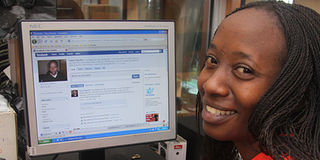Understanding Africa’s media

Internet consumers in Kenya are set for faster connectivity after a new fibre optic cable came into operation in the Indian Ocean. Photo/FILE
Title: Media and Identity in Africa
Editors: Kimani Njogu and John Middleton
Publisher: Edinburgh University Press for International Africa Institute
Year of Publication: 2009
Reviewed By TOM ODHIAMBO
The two subjects of media and identity that make up the discourse of the book under review probably are the most discussed topics in the world today.
Consider the way we Kenyans have flirted with national destruction all in the name of identity thinly strapped around our ethnicity, party, socio-economic class or religion.
Again, consider how the expanded “media space” has been integral in “disintegrating” rather than integrating us. Hate-mongering spews from the motor-mouths running programmes on FM stations, and SMSes have the capacity to spawn fear among wananchi.
Quite refreshing
It is, therefore, quite refreshing and enlightening to read a book that seeks to retable the media and identity agendas, especially on and in Africa.
Media and Identity in Africa comes out of a seminar that was held in Nairobi in August 2004 entitled ‘Media and the Construction of Identity in Africa’.
The two editors, Prof Kimani Njogu and Prof John Middleton, are recognised Africanists. Prof Njogu is a leading scholar on the subjects of culture and identity in Kenya today. Prof Middleton, a professor emeritus of Anthropology and Religious Studies at Yale University at the time of his death, edited the journal Africa between 1973 and 1979.
The collected essays are divided into three parts: 1) The media, community and identity; 2) The media and identity: The global media; 3) The media and identity: The local media.
Each part is made up of essays by leading scholars in African history, anthropology, culture, religion, literature and the media.
In most cases the essays draw their conclusions from empirical research on a number of topics such as popular culture, morality, Pentecostalism, consumerism, language, politics, photography, literary prizes, names and cloth, oathing, matatu culture, cartoons and music. It has an engaging epilogue by Valentin Mudimbe, the African philosopher.
But what really makes this book a significant contribution to scholarship on African media and identity is methodological and theoretical departures that have enabled the different contributors to read media from a wide range of material and symbolic texts.
Strange things possible
Also, the interdisciplinary mix of the contributors, each addressing the subject of media in and on Africa and how it frames and is framed in turn by different and differing identities, has contributed to a text that would easily be readable across the various disciplines in the academy as well as the non-academic reader.
For instance Heike Behrend’s essay, “To Make Strange Things Possible: the Photomontages of the Bakor Photo Studio in Lamu, Kenya”, is a journey through the history of Lamu and one of its oldest photo studios, The Bakor Studio.
In this essay the reader encounters the coastal culture, a brief family history and that of photography and its impact on people. But beyond history Behrend’s essay invites us to engage with the subject of visual media, especially one that is intimately tied to the lives of many Africans irrespective of the socio-economic differences, photography.
New inflection
There are many other essays in this collection which add a new inflection to our understanding of media, socially given that media today is versatile and ever-changing.
A consequence of media versatility is the little attention that scholars on media have given to old media and texts that have otherwise not been understood as media. For instance, little attention has been given to the capacity of cloth to act as media.
Yet throughout the 2007 election campaigns in Kenya, one’s dressing immediately communicated which side of the political divide one belonged to (or it was assumed so).
Kenyans’ obsession with wearing suits even during the dry season when temperatures soar above 30 degrees centigrade is a significant message of how Anglophile we are.
The Internet and its corollaries such as Google, Twitter, Facebook, I-reporting, the FM stations and their popular call-in programmes, Internet publishing etc may be the things that define media today. Yet these forms of media are still to be accessed and used universally.
If one adds identity politics to the mix of media and its various forms, especially in Africa, then one realises that it is just as imperative to understand how the new media is reframing people’s lives today as it is to appreciate how within their respective communities individuals still rely on other media forms that may not be so obvious.
For instance, we need to interrogate how changing modes of dressing such as hairstyles, use of studs, bracelets, tattoos and so on are adopted by different social groups as forms of self and group expression because it is through such acts that often people and societies signal their differences and communicate their identities.
Dr Tom Odhiambo teaches literature at the University of Nairobi.
Email: [email protected]




